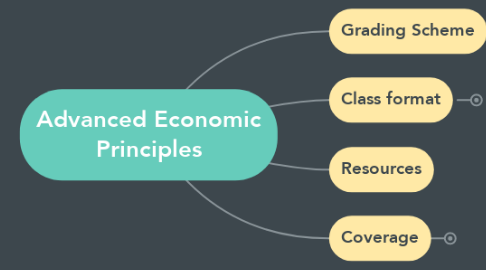
1. Grading Scheme
1.1. Topic Presentation 45%
1.1.1. Quality analysis
1.1.1.1. Major issues are addressed
1.1.1.2. Relevant tools are used properly
1.1.1.3. Assumptions for analysis are stated clearly
1.1.1.4. Causes of the problems are identified in the analysis
1.1.2. Exhibits
1.1.2.1. Analyses in the exhibits are done correctly
1.1.2.2. Exhibits support and clarify key points
1.1.2.3. Not more than 7 exhibits
1.1.3. Recommendations
1.1.3.1. Criteria for selecting alternative recommendations are given
1.1.3.2. Criteria are appropriate
1.1.3.3. Plan of action is logical linked to the analysis
1.1.3.4. Plan of action is specific, complete and practical
1.1.3.5. Recommendations are likely to achieve intended results
1.1.4. Presentations
1.1.4.1. Report is not long, 2000 words max
1.1.4.2. Presentation is professionally done
1.1.4.3. Report is consistent and effectively sells its recommendations
1.2. Assignments 45%
1.2.1. Exams Last meeting
1.2.1.1. Bring exam admission slip
1.2.1.2. Use 50 leaves bound notebook
1.2.1.3. Coverage (all focus questions not covered in the discussions)
1.2.2. Essays
1.3. Class participation 10%
1.3.1. Contextual
1.3.1.1. Willingness to participate and attentive to discussion
1.3.2. Innovative
1.3.2.1. There is willingness to test new ideas and comments are not confrontational.
1.3.3. Insightful
1.3.3.1. Comments are appropriate and indicates insightful analysis of case data
1.3.4. Relevant
1.3.4.1. Comments are relevant to current discussion and linked to comments of others
1.3.5. Supported
1.3.5.1. Comments clarify important aspects of earlier ideas and lead to clearer statement of relevant concepts and issues
2. Class format
2.1. Dialogues & Discussion
2.2. Preparation & Participation
2.3. Addressing Focus Questions
3. Resources
4. Coverage
4.1. 1. Ten principles of economics
4.2. 2. The market forces of supply and demand
4.3. 3. Economic theories on how people make decisions
4.3.1. Game theory
4.3.2. Marginal Productivity & Cost analysis theory
4.3.3. Behavioral Economics
4.3.4. Prospect theory
4.4. 4. Economic theories on how people and markets interact
4.4.1. Heckscher-Ohlin trade model
4.4.2. Comparative advantage theory
4.4.3. New trade theory
4.4.4. Creative destruction theory
4.5. 5. The ASEAN Integration 4 Pillars, Objectives, Coverage, Benefits, Challenges
4.6. 6. Economic theories on how the economy works as a whole
4.6.1. GNP/GDP Measurement
4.6.2. Purchasing Power Parity
4.6.3. General Theory of employment, Interest and money
